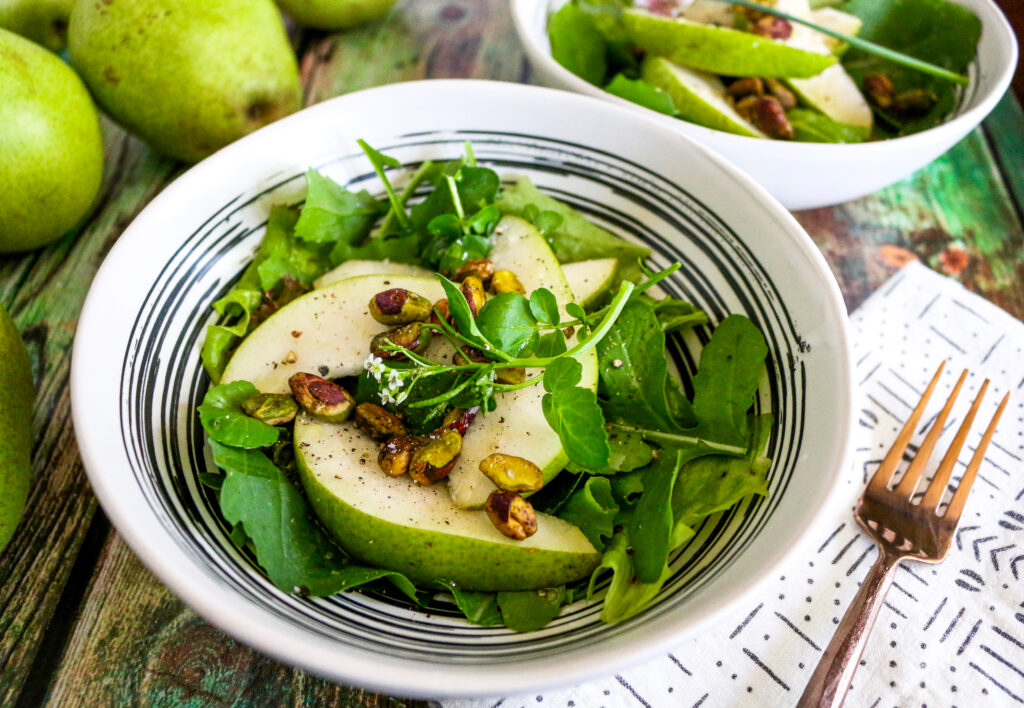5 Tips for Green Eating

What you put on your plate is one of the most powerful impacts you can make on your environmental footprint over your lifetime. So learn how to go green on your plate with these top 5 tips for green eating.
With every bite, you make an impact on the planet. In fact, your style of eating can be one of the most powerful tools you, as an individual, may have to impact a number of environmental issues, such as green house gas emissions, water and land usage, energy consumption, and contamination of waterways. Did you know that agriculture takes up about half of the planet’s land surface, and 70% of the global water supply? Animal agriculture is responsible for 14.5% of our total greenhouse gas emissions. Try to do your part to preserve this precious planet for the next generation with my five top tips for greening your plate.
5 Tips for Green Eating

1. Eat more Plants, Less Animals
Vegetarians have a 30% lower carbon footprint than meat eaters, according to research. And just moving to a semi-vegetarian or flexitarian diet (small amount of animal foods are consumed) can make a difference—semi-vegetarians have a 20% lower carbon footprint. Why does a plant-centric diet make such a difference? Well, it’s easy: You can grow plants and eat them, or you can grow plants, feed them to animals (who require lots of land, water, and food—and produce lots of manure and methane), and eat the animals. It’s much more efficient to eat the plants.

2. Eat more Whole, Minimally Processed Foods
Every time you eat a highly processed food—a food that doesn’t bear any resemblance to its origins—you increase your carbon footprint. For example, a highly processed “nutrition” bar, with corn syrup as the number one ingredient, doesn’t look anything like an ear of corn. And all of those ingredients listed on the nutrition bar wrapper had to be processed somewhere, and then transported to the nutrition bar processing plant, where they were assembled, packaged, and then transported to your nearby store. Think of the inputs required to get that bar to your pantry, compared to an ear of corn you picked up at the farmers market. Iowa researchers found that the ingredients in a single carton of yogurt traveled 2,211 to get to the processing plant. And that’s just yogurt!

3. Cut Down Food Waste
Did you know that every day in the U.S., we waste enough food to fill the Rose Bowl? I live really close to the Rose Bowl, and let me tell you, it’s big! In fact, more than 40% of the food produced for consumption in the U.S. will never be eaten—it’s enough to provide 1,400 calories per day. What’s the big deal? Just think of all the resources—not to mention animal lives—that went into producing the food that never even gets consumed. If you really want to make an impact on your carbon footprint, just cut out wasted food. Don’t over-purchase food, order smaller portions at restaurants, pack away leftovers, plan menus during the week to maximize food usage, and make a weekly soup to take advantage of leftover vegetables, grains, proteins, and broths.

4. Grow Some Food
We used to eat far more sustainably. Much of the food we consumed came from kitchen gardens and the local environs through hunting and gathering. Families preserved their bounty of food to last through the winter. Enter the modern world, where everything comes from the supermarket! You can make a difference by growing even a small amount of your own food. The average family vegetable garden provides $600 worth of vegetables (that you don’t need to have transported all they way to your kitchen!), according to the National Gardening Association. Rip out one flowerbed and turn it into a vegetable garden. Ditch the ornamental tree in favor of a fruit tree. If you live in an apartment, try a tomato plant on the balcony. Foster that green thumb.

5. Buy More Locally
Local may be the hot buzzword. And it’s important, as foods travel from ever increasing distances to get to your plate. Swedish researchers found that a typical Swedish breakfast of apple, bread, butter, cheese, coffee, cream, and sugar traveled in total the distance of the Earth’s circumference to get to a Swedish breakfast plate! Sure, the stats vary, depending on where you live, but you get the picture. Cut down on the distance your food travels by buying more products that are grown closer to home. One of the best ways for greening your plate is to grow your own food, but the second best way is to support your local farmers market or CSA (community supported agriculture), where you can find all manner of food—fruits, vegetables, dried beans, nuts, oil, eggs, meat, and fish—produced in your own community.
For other blogs on sustainability, check out these:
Top 20 Eco Friendly Gift Guide for the Kitchen
The Many Benefits of Learning How to Grow Your Own Food
Upcycling in the Kitchen
7 Environmentally Friendly Kitchen Tips from Dietitians
5 Ways to Get Involved in Your Local Food System
Plant-Based Diets: The Path to Healthy Sustainable Eating




